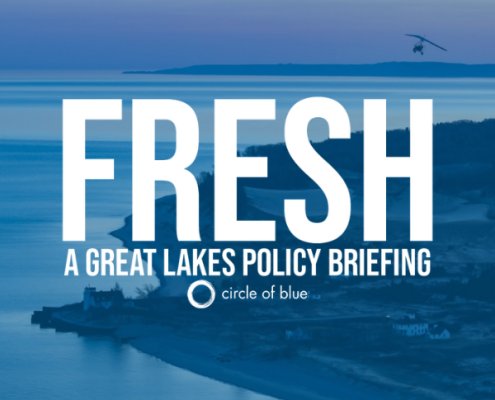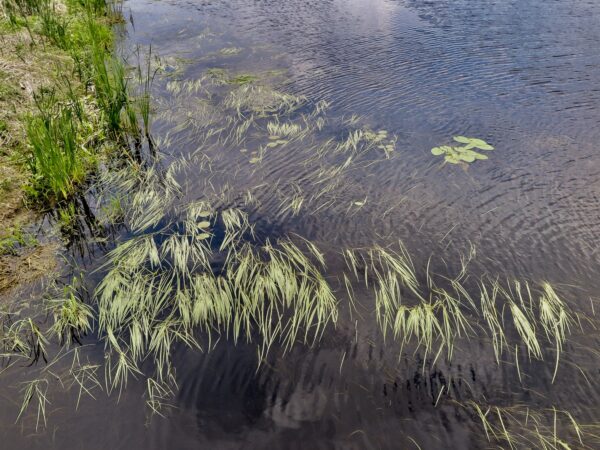
June 13, 2023
Fresh is a biweekly newsletter from Circle of Blue that unpacks the biggest international, state, and local policy news stories facing the Great Lakes region today. Sign up for Fresh: A Great Lakes Policy Briefing, straight to your inbox, every other Tuesday.
— Christian Thorsberg, Interim Fresh Editor
This Week’s Watersheds
- The Litchfield Wetlands Nature Preserve, a new protected area in Medina County, Ohio, has opened to the public.
- Huge amounts of lime chemical byproduct, which have blighted Montague, Michigan, and its nearby water sources for decades, may finally be ordered to be cleaned.
- A proposal to build a barrier preventing invasive silver carp from traveling up the Mississippi River has died in the Minnesota Legislature.
- Nineteen drinking water utilities in Indiana were found to have PFAS levels above federal health guidelines.
A decision to allow a relief sewer, which would drain raw waste into the Detroit River during rainstorms, is being met with pushback.
“If you recall all the things that people have gone through in Jefferson Chalmers, basement backups, feces in the basement. So now we are going to take the waste and put the waste in the Detroit River and affect Detroiters even more.” — Mary Waters, Detroit City Council Member.
The Michigan Department of Environment, Great Lakes, and Energy has approved a permit allowing Grosse Pointe Park to build a relief sewer — an “emergency relief valve” that would drain raw sewage directly into the Detroit River during periods of extreme rainfall.
The pushback is led by city council member Mary Waters and residents of Detroit’s Jefferson-Chalmers neighborhood, who will be directly impacted by the decision and continue to experience flooding and “ecological emergencies” during wet seasons.
In Context: In Flooded Michigan Neighborhoods, Who Should Pay For Sea Walls?
Fresh from the Great Lakes News Collaborative

- Debt ceiling law raises questions on timeline of Line 5 tunnel environmental review — Michigan Radio
- Michigan bills would give farmers ‘right to repair’ tractors, equipment — Bridge Michigan
- Illinois, feds grapple with agreement that would advance billion dollar plan to stop invasive carp — Great Lakes Now
The Great Lakes News Collaborative includes Bridge Michigan; Circle of Blue; Great Lakes Now at Detroit Public Television; and Michigan Radio, Michigan’s NPR News Leader. We work together to produce news and information about the impact of climate change, pollution, and aging infrastructure on the Great Lakes and drinking water. This independent journalism is supported by the Charles Stewart Mott Foundation. Find all the work here.

The Lead
Silver carp, a fish that is not native to Minnesota, have been seen more frequently near the state’s waterways — bunches of 30 and 50 adults have been found over the past two years downstream near the Wisconsin border, and individual carp have been caught in the Twin Cities’ St. Croix River. Land-use planners and biologists warn that if invasive carp begin settling and spawning in Minnesota, there is a high likelihood that native fish populations will suffer, along with river health and local economies, Minnesota Public Radio reports.
This is why, with a $17 billion state budget surplus, environmental advocates asked for $16.8 million to fund preventative measures against carp, including a bio-acoustic fish fence for the Mississippi River near Winona.
To their disappointment, lawmakers decided instead to allocate $1.72 million “to expand the Minnesota Department of Natural Resources’ invasive carp prevention and management efforts.”
“I think people will be very, very shocked and disappointed if something that was preventable was allowed to happen because of inaction or decisiveness, at a moment when we still had an opportunity,” Whitney Clark, executive director of the nonprofit Friends of the Mississippi River, told MPR.
In the News
Litchfield Wetlands Nature Preserve: The new preserve, which officially opened to the public last week, received a $900,000 grant from the Ohio Department of Natural Resources’ H2Ohio program, the Medina County Gazette reports. Parks specialists and ecologists created the protected area — 150 acres in total, 80 of which are wetlands habitat – over the course of two years. The wetlands are designed to trap nutrients and sediment before they wash into Lake Erie. Some 1.7 miles of trails are also available for use. The land had been farmed for soybeans.
Indiana PFAS: A recent series of tests administered by the Indiana Department of Environmental Management (IDEM) found that ten mid-size drinking water facilities, and nine small facilities, have levels of PFAS above federal health guidelines, Indiana Public Radio reports. The results from these tests are being updated on the IDEM website. The state’s largest water facilities have yet to be completely tested.
Looking Ahead
DuPont Lime: For decades, close to 580,000 cubic yards of lime byproduct — which, though it isn’t highly toxic, contains arsenic and thiocyanide — has sat uncleared in Montague, Michigan, despite residents’ calls to address the pile. It continues today to leak into soil and adjacent water sources, including Mirror Lake, while polluting the surrounding forest, creeks, and bayous. The 1,300-acre property on which the lime sits was a former DuPont manufacturing site — which is now owned by Chemours, a DuPont spin-off — and borders Lake Michigan and White Lake. To the relief of locals and advocates, Chemours and the Michigan Department of Environment, Great Lakes and Energy are negotiating a consent order, which would “codify the company’s cleanup obligations and schedules,” Michigan Live reports.
Other News
Gibraltar Bay Unit: A new trail will connect Grosse Ile, Michigan, with the Gibraltar Bay Unit, a 41-acre parcel of green space and waterways “stewarded by the Grosse Ile Nature and Land Conservancy, and the International Wildlife Refuge Alliance,” Great Lakes Now reports.
Beech Leaf: Beech trees around Lake Erie are being increasingly threatened by Beech Leaf disease, the incidence of which has tripled from 2019 to 2022 in the region, InsideClimate News reports.
Catch more news at Great Lakes Now:
FRESH: New Wisconsin Law Aims to Protect Watersheds From Farm Runoff




